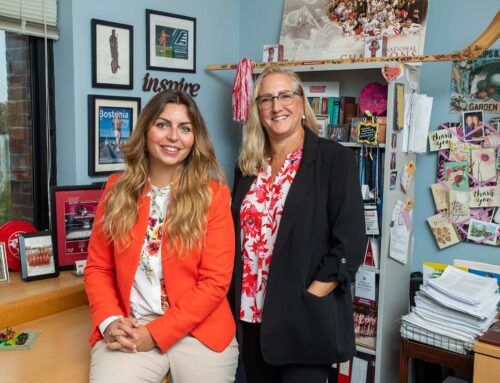Worcester Magazine
July 2016
For many people, mealtimes are not always about the food. Maybe you’re talking with a family member or a date, maybe you’re absorbed in an episode of your favorite TV show, or maybe you’re just scarfing something down at your desk at work.
Eating can be taken for granted, but for someone with an eating disorder, it can be a tortuous exercise. Alicia Saladino knows that all too well.
When the high school senior from Webster went to Walden Behavioral Care, the counselors had to distract her and others in the program from the meal at hand so they could get some food down.
“We would talk and play games,” Saladino told Worcester Magazine recently. “You’re still focusing on the meal, but you’re not so focused on it that you can’t deal with it.”
“Dealing with a meal” may seem like a foreign concept to some, but for Saladino and others suffering from anorexia, a condition whose victims starve themselves in the quest for a different body image — one that has claimed countless lives — simple tasks can become trials.
Saladino said her condition degenerated to the point where she would hole up in her room.
“I did not want to leave my house, ever,” she said. “I didn’t want to be in front of people, I didn’t want people to look at me. I was so self-conscious that I was like, I don’t want to go to parties. I would just sit in my bedroom all day. Even if it was just friends, I wouldn’t want to go over their house.
“At my house I could do what I wanted to do with my food. I didn’t know what
Now, Saladino is healthy and speaking out about her condition. For that, she credits Walden, a private, Waltham-based company with an office in Worcester that treats anorexia, bulimia, binge-eating and other eating disorders. The organization claims to have helped many people overcome their food issues through a “whole person” approach and a unique treatment strategy that helps people at whatever level of care they require.
Walden’s Worcester location may be unassuming, but it is a key outpost in the organization’s mission of treating an often-overlooked disease.
THE DISORDERS
“Anorexia nervosa is characterized by emaciation, a relentless pursuit of thinness, a distortion of body image, an intense fear of gaining weight, and extremely disturbed eating behavior,” according to the National Institute of Mental Health. “Many people with anorexia see themselves as overweight, even when they are starved or are clearly malnourished. Eating, food, and weight control become obsessions for people with anorexia.”
Anorexia is just one of the many types of eating disorders – and one of the most deadly. A 2011 study found anorexia has the highest mortality rate of any psychiatric disorder, which makes the fact that only about a third of people with the condition are currently receiving treatment worrying.
Laura Roias, program director for Walden’s Worcester branch, said eating disorders are particularly problematic because it is not just about mealtime – having a distorted body image, and eating unhealthily because of it, leads to all kinds of problems, not just for the person affected, but for their friends and loved ones.
“I’d say eating disorders don’t leave any aspect of one’s life untouched,” Roias said. “They affect school, work, attendance. If you’re constantly in treatment you can lose your job, or not pass [a class]. They definitely impact relationships, family, friends. A lot of people describe it as an ambiguous loss. Your family member or friend is still physically there, but they’re not the person you used to know because they’re so consumed with food thoughts or weight thoughts. They’re just sad and lifeless. Because it impacts your mood and your hobbies, most people don’t know who they are. They don’t get joy out of anything.”
Eating disorders also have a significant genetic component.
“Usually, what happens is someone has the genetic predisposition and something sets it off,” Roias said. “Whether it’s a major life transition like going to college or high school, a death in the family, a trauma – something like that can trigger it.”
Of course, no amount of statistics or data or medical reasoning is going to make someone with an eating disorder think other people truly grasp what they are going through.
“One of the biggest complaints patients have is that nobody understands,” Roias said. “And that’s why it’s so important for people to get a better understanding of what it’s like. Because intuitively, it doesn’t make sense. Why doesn’t she want to eat? What’s the problem?”
“That’s the most common question. ‘Why don’t you just eat this?’” Saladino interjected. “Because I don’t want to, that is why. Or because it makes you feel so physically sick to your stomach.”
CHECKING FOR CLUES
Saladino’s mother, Karen, brought her daughter to Walden. She said one of the most crucial moments was when she went with Alicia to buy a prom dress, and saw her daughter’s true weight for the first time.
“I thought I was going to have a heart attack. The bones,” Karen Saladino said. “She always wore baggy clothes, so I never noticed before.”
That’s a potential symptom of an eating disorder – someone wearing baggy clothing to hide what his or her body looks like. Roias can tick off a long list of other warning signs.
“Any changes in exercise, and getting very agitated if you can’t exercise,” Roias said. “Disappearance at mealtime. Sudden changes in dressing – either very baggy clothes to hide one’s body, or wearing really tight-fitting clothes to try to be in a smaller size. Avoiding social situations that might involve foods.”
The problem lies in a denial of the problem by the person who needs help. Saladino said she did not think anything was wrong with her, and had to be hoodwinked into an appointment at Walden.
“My mom tricked me by saying I was going to a doctor’s appointment, and brought me [to Walden],” Alicia Saladino said. “I had absolutely no idea. I thought everything was fine.” Her story is not unusual. Roias said while clients do not need a referral to come to Walden for treatment, many times a family member is the one to identify a problem, while the client needs some convincing.
“Some people acknowledge something’s off with their eating patterns, but can’t quite pinpoint it, or think that changes in their eating habits are normal or healthy when they’re actually not,” Roias said.
In hindsight, Karen Saladino said, it was clear something was off with her daughter. Chopping up a salad for lunch, mood swings, constant fatigue and complaining of being cold during the summer were all red flags – but in a society where knowledge of eating disorders is not widespread, those red flags can often escape notice.
“I knew she was losing weight, but she was doing a lot of exercising, I didn’t think anything of it,” Karen Saladino said. “I noticed that it would take a lot longer to eat. It could take up to an hour to eat sometimes. As a parent you don’t notice all these signs. Until she started the program – I was like, all those signs were there, now that I think about it, all the different things.”
Alicia Saladino said she suddenly started avoiding foods she had previously loved – another bad sign. She said she would not let anyone else prepare her meals, needing complete control over her eating habits. “I refused to touch any type of pasta, bread – I was terrified of carbs,” Saladino said. “[Be careful] if someone is staying away from a certain type of food you know they like.”
Other potential symptoms of an eating disorder include making food so hot or cold it is unpalatable, according to Roias, or making odd food combinations that don’t make much sense.
MYTHS AND STEREOTYPES
“Almost everything people believe about eating disorders is inaccurate,” Roias said.
One of the biggest misconceptions surrounds the demographic that is affected by eating disorders. The stereotype, sometimes alluded to in the media, is a young girl either starving herself or “purging” after a meal to look thinner. But Roias said that stereotype is wrong, and ignores other segments of the population.
While anorexia, bulimia and binge-eating are more common in females, men also suffer – 0.3 percent of American males suffer from anorexia, according to NIMH, compared to 0.9 percent of females, and the gap is similar across other eating disorders. Roias said Walden sees all types of clients.
“They don’t just affect women or girls,” Roias said. “There’s a perception that it’s a white, middle-class thing. But really they don’t discriminate. They affect everybody.”
Eating disorders are also not voluntary – which may seem like an obvious statement, but there is a perception among some that anorexics and bulimics are just trying to lose weight to look good, a distinction that can make the disorders hard to identify.
“They’re not a choice, and they’re not simply about being thin, or seeing these beautiful models in magazines,” Roias said. “There’s so much more going on.”
Alicia Saladino concurred. “I feel like telling someone who has an eating disorder to just eat is the same as telling an alcoholic to just not drink,” she said. “It’s just so much more.”
Alicia Saladino’s advice for others struggling with an eating disorder is to talk to somebody about it.
“Don’t try to keep it all in,” she said. “That’s not fun.”
THE COLLEGE CURSE
That aligns with advice from Martha Sullivan, director of Health Services at Holy Cross, who said she has seen students share details of their struggle with friends on campus and witnessed positive results – thus, dispelling a fear people with a disorder might have about stigma or being shunned.
“I think it’s hard for students to share that information. They keep it hidden and struggle alone,” Sullivan said. “But I’ve also noticed that once students are able to share it with their team, with their trainer, with their group of friends – those friends rally around them and are supportive of them.
In my experience, when they are able to share, instead of feeling shamed, the students here rally around them and are supportive of them.”
Statistically, female college students are among the most susceptible to eating disorders. The Multi-Service Eating Disorders Association found that 25 percent of college-aged women engaged in binging and purging as a weight-management technique, and a 2006 National Eating Disorders Association survey found 20 percent of college students reported having an eating disorder. And one 2011 study studying 13 years of data at one university found eating disorders were rising, from 23 percent to 32 percent in females and from 8 percent to 25 percent in men.
Eating disorders are also not just a fad or a phase. NIMH reports there are not “statistically different lifetime rates” for people between age 18-59 for any of the three most common eating disorders. That age range increases to 60-plus years when it comes to anorexia.
“You don’t just grow out of it,” Roias said. “It’s not like somebody turns 30 and suddenly it’s gone. We treat a lot of people who are in their 50s or 60s or 70s who are still struggling.”
GETTING OVER IT
Alicia Saladino started coming to Walden for treatment last June, starting in the inpatient clinic in Waltham, where she lived with a number of other clients.
“It was probably the roughest week of my life, and I hated everyone during that week,” she said.
Over time, she started to realize she had a problem and began to appreciate the care she was given. Part of making it over that hump was realizing what, exactly, Walden was all about.
“I think there’s a huge fear factor, thinking that if you go to treatment the whole point is to make you fat, and they discharge you and you’re fat,” Roias said. “People don’t understand what treatment looks like and don’t want to be judged.”
Alicia Saladino said she did not feel judged going in – except by herself.
“That was my biggest complaint,” she said. “I thought, ‘They’re going to make me fat, I’m going to be disgusting, and I’m going to weigh more than I did before.’ You don’t want to change, because you’re so comfortable with it. But you’re destroying your body.”
After some time in a hospital setting, Alicia Saladino was transferred to an apartment-style living arrangement, and eventually cut down her treatment to therapy visits a few times a week. The ability to meet clients where they are in their lives – offering the least restrictive level of care possible, and staying with them from the start of treatment through recovery – is what makes Walden unique, Roias said.
“We’re known for our systems of care,” Roias said. “We have an inpatient unit, a residential program, a day program, and a half-day or evening program. So people have options, it’s not like if you don’t meet an inpatient level of care we can’t treat you, or if you can’t drop everything in your life for treatment … We’re the only place in New England that has a full continuum of care, and one of probably only two or three in the country.”
In addition to Waltham and its Worcester branch, Walden has locations in Peabody, Braintree and Amherst as well as a growing presence in Connecticut. Actually, the organization as a whole is expanding – not necessarily because of an increase in eating disorders, but because more people can seek out its services, which can be covered by health insurance.
“I think treatment has become more accessible,” Roias said. “People in Massachusetts have more health insurance today. But there’s also more education, and doctors are able to diagnose and refer more people to treatment. And there’s fewer barriers to care.”
Still, even with its multitude of hospitals, the Bay State has not been a historic powerhouse when it comes to eating disorder treatment. Roias cited Florida, Arizona and California as the leaders in that role. But recently, Walden and others have started making treatment more easily available to people who could not afford out-of-pocket trips to specialized locations.
“Historically, you sent a person with an eating disorder off to a boutique-type resort,” Roias said. “But that model has really shifted. Those were mostly self-pay options.”
Walden’s model is not just about helping people gain back weight, although that is part of it. The main goal is to treat the whole person by offering counseling and other services, helping clients see the world – and themselves – in a better way. The mix of methods was effective for Alicia Saladino.
“They had a kitchen in there, and tables set up,” she said. “If you weren’t able to finish a meal, they would always go around and be very positive about trying to get you to take one more bite. But if you really couldn’t do it, they did have Ensure and Boost as a supplement, so you would still get what you need.”
But someone has to walk through the door before treatment can start – a challenge for such a stigmatized disorder. The good news, according to those in the know, is there is life after treatment.
“If someone has to leave to get care, they might see it as the end of the world, but in my experience the majority come back and they do walk across that stage and get their diploma,” Sullivan said.
Treatment does not start and end at Walden, of course. Especially for college students on one of Worcester’s many campuses, it can be a challenge to handle classes, social pressures and an eating disorder all at once. Sullivan said there are four psychologists and a nutritionist every other week at Holy Cross, ready to collaborate with primary care physicians to get students the help they need.
“Of course, there are challenges when students are restricting and need to eat in a group setting,” Sullivan said. “The ones that come and see our nutritionist and are following their plan of care, they’re carrying a bag around with them in their knapsack. So they have their morning snack and afternoon snacks, so in the busyness of their schedule they have the opportunity to meet their goals.”
Walden also tries to involve parents or a client’s support system as much as possible. While not always available, a strong support network does wonders for recovery. There are separate “parent meetings” at Walden, and parents receive nearly as much education on eating disorders as their children, something Karen Saladino said was a huge help.
“I cannot rave about this program enough,” she said. “When I first started, they said you have to be involved. I would have to come twice a week, and I would bring the meal. They would give me a meal plan, and I would bring it. But the first time they told me, I was like, I’m not the one with the problem. I don’t understand why I have to do this. But the more I thought about it, I thought, how is she going to come home if I don’t understand what’s going on?
“They taught us how to feed her again. By the time she got to the outpatient and got home, I still did her meals for another month or so. By that point, I was all set with the program.”
STIGMA AND SOCIETY
At Walden, Alicia Saladino said, the group watched movies instead of television because of the glut of exercise and diet ads that can serve to set people with eating disorders into a spiral of doubt, putting the focus back on losing weight instead of being healthy.
“There are so many diet commercials and ads everywhere,” she said. “It is the hardest thing ever. When you’re stuck in a place for a month and you want to watch TV, it’s really hard because they can’t find a station … It’s not a bad thing if someone is really overweight and they do need to do that, but to the excess is so much, and it just starts making people feel bad.”
Unrealistic standards for beauty and body images are nothing new in American society, and affect everyone, not just people with eating disorders. But other, more well-intentioned measures may backfire when it comes to people with eating disorders. Calorie counts on food choices in restaurants are a big one. Alicia Saladino said before she went into recovery she would obsessively check calorie counts on foods she ate, and while the counts may benefit someone on a healthy diet, they discouraged her from eating as much as she should have.
“One of the hardest things for me still is to be able to not look at calories and just eat something,” she said.
Massachusetts is one of a handful of U.S. states requiring calorie postings at chain restaurants. While single restaurants may choose to voluntarily display health information, anorexic or bulimic residents cannot visit even typically health-unconscious fast food joints in Massachusetts without feeling pressured and fenced in.
“You can’t go to a restaurant without seeing calories posted everywhere, and there’s always asterisks next to a food item that says ‘lite, fit option,’ and there’s a significant amount of guilt and shame around making food choices that aren’t deemed healthy,” Roias said. “And that’s difficult for anyone to live around … I don’t know that it’s reaching the people it needs to reach.”
There are other issues for people with eating disorders in recovery, Roias said. Among them is an obsession, in school and the workplace, with minimizing mealtime to maximize “on the clock” work. Leaving out time for meals may be good for productivity, she said, but it is bad for health.
“Our culture doesn’t do a good job of prioritizing sitting down and having a meal,” Roias said. “Schools have really shrunk the time kids have to eat. You have to scarf your food down. And you look at fields like medicine, and people eating at their desks – there are cultural things that play into that.”
Getting reintroduced to the “real world” of food and eating can be difficult for Walden clients. The process has to be slow and thoughtful, not rushed – as was Alicia Saladino’s first visit to a restaurant after months of carefully crafted meals.
“We went into Boston one day, and it was the first time they had increased their meal plan, and it was also the first time we had done a restaurant,” Karen Saladino said. “We tried, and it was awkward. It was probably the worst meal we ever had.”
Speed bumps aside, Alicia Saladino is back to her old self, with considerably more of a balanced outlook on nutrition and stigma than many her age. Platitudes such as “people will love you for you” may be true, she said, but that doesn’t mean they are helpful in an image-obsessed society – or high school.
“You can always tell people they don’t need to care about how they look. But it’s a hard thing to grasp. It’s so ingrained in everyone’s minds that we need to look a certain way,” Alicia Saladino said. “I got compliments in school from [losing weight], before I got really really bad. And it’s always in your head that you can look even better. And you’re never satisfied.”
LIFE AFTER TREATMENT
When she was in recovery, Karen Saladino took the mirror out of her daughter’s room. It still hasn’t returned, even after the recovery, and the younger Saladino said she is not sure she wants it to.
“Days come and go,” Alicia Saladino said. “I’m recovered, but I still have my days. It’s one of those things that’s not going to leave, it’s always going to be in the back of my mind. But I don’t let it take over.”
Karen Saladino, meanwhile, said she is ever-grateful to her daughter’s high school for recommending Walden, and said there was no way the family could have handled the condition alone.
“I don’t see how anybody can do it without support,” she said.
While platitudes may fall on deaf ears for those living with an eating disorder, part of the magic of Walden is to make the things others take for granted palatable to people who can’t keep food down, or can’t stop eating.
“You don’t have to live hating your body,” Roias said. “And you don’t have to live life feeling guilty about something you ate three days ago.”
And while the individual or loved ones should seek help, there are definitely societal changes that could cut down on eating disorders, or at least make it easier for those with a problem to seek help without feeling judged.
“The media messages for men and women of thinness – all media should change to get [people] accepting who you are,” Sullivan said. “Everyone has different body types – the thin model is not the ideal body type for everybody.”
When she was going through Walden’s program, Alicia Saladino said she did not want anyone to know where she was. Today, she is ready to serve as an advocate for people with eating disorders, and an example for others in her situation who may feel like they have nowhere to go.
“Now, I’m OK with it,” she said. “Now I just want other people who are going through it to get better and get the help that they need. It’s not good to see other people suffer through it, because you know exactly how they’re feeling. If I could scream from the top of a building for everyone to come here, I would.”






